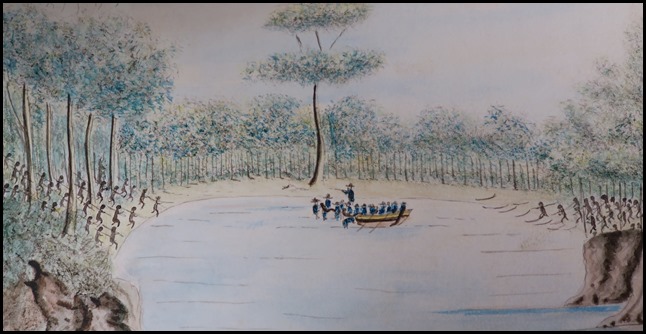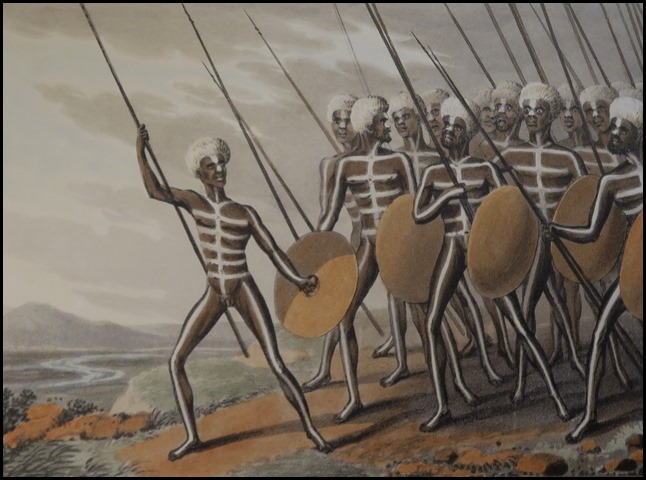Early Relationships

Beez Neez now Chy Whella
Big Bear and Pepe Millard
Sat 9 Jan 2016 23:47
|
Early Relationships with the Aboriginal
People  In a side room off the main hall we read about the early
relationships between the First Fleet and the local Aboriginal
people.
Clans of the
Sydney Region: Australia holds an extraordinary diversity of Aboriginal
cultures, with an estimated two hundred and fifty different languages once
spoken across the continent. Even in the relatively small region of Sydney there
were at least thirty district clan groups, speaking several languages, including
Darag and Dharwal. Each clan was associated with specific areas of land, and
distinguished by totems [usually animals] and unique cultural elements such as
songs, dances, body decorations and designs.
Gadigal land, where the Museum of
Sydney now stands, covered the south shore of Sydney Harbour from Watsons Bay to
Sydney Cove.
Names for clans were recorded with
various spellings and colonial confusions, so mapping them today is difficult.
The clan names in brown were identified by British Officers of the First Fleet.
Other names were recorded later and may refer either to clans or to places where
Aboriginal people lived after the impact of diseases and the encroachment of
European settlers on their land. While incomplete, this map indicates some of
the known clans and groups before and after
contact, showing the complexity and ongoing variety of Aboriginal communities in
the Sydney region.
 Gadigal Place: The Aboriginal people
who encountered the First Fleet in 1788 belonged to a sophisticated and
culturally diverse population whose ancestors had lived in this region – now
called Sydney – for at least forty thousand years.
The coastal Eora [meaning ‘people’]
were saltwater people, who lived on the rich resources of the harbour and
rivers. They excelled at fishing and manoeuvring simple bark canoes –
nowey – through the roughest surf. On display in this gallery are traditional tools and weapons, made by Aboriginal people
today, representative of the lifestyles of the clans of this
region.
Fifteen months after the arrival of
the First Fleet, Sydney’s Aboriginal clans were decimated by an outbreak of
smallpox, which caused terrible suffering and social upheaval. It is estimated
that the disease killed between fifty and ninety per cent of the
population.
Yet, through cultural resilience and
astonishing adaptability, the Aboriginal people of Sydney have survived. They
are today a dynamic part of the city with deep spiritual connections to this
land. This gallery is dedicated to the Gadigal clan and all Aboriginal people of
the Sydney region.
 The Taking of Colebee and Bennelong. 25th of November 1789
by William Bradley,
1790.
At first the Aboriginal clans of
Sydney were wary of the new colony, and kept their distance. Governor Phillip
wanted to build friendships with the local people, to limit conflict and to
learn about local resources. With food supplies dwindling by 1789, this seemed
ever more urgent. So Phillip took a desperate step: kidnap.
First Arabanoo was captured, and when
he died of smallpox, two more men were taken. Bennelong of the Wangal tribe and
Colebee of the Gadigal were lured to a boat with the promise of fish and seized
by marines at Manly Cove.
Taken back to the colony, shaved and
clothed, the Aboriginal men were detained on this very site, in the first
Government House. Colebee escaped within a few weeks, with a leg-iron still on
his ankle, but Bennelong, who was well liked by his captors, stayed for six
months.
 The Governor making the best of his way to the boat after
being wounded with the spear sticking in his shoulder. This painting by a Port
Jackson painter, circa 1790 along with the next two seen below.
What happened next would shock the
infant colony. Less than a year after the kidnapping, Bennelong and Colebee
invited Governor Phillip to visit manly, where locals were feasting on a whale.
An exchange of gifts and friendly conversation took place, then suddenly a man
named Willemering came forward and speared Phillip in the shoulder.
Was this daring act of violence
towards the colony’s leader an act of war ? Or perhaps just a misunderstanding ?
Both seem unlikely given the friendly exchanges that had just taken place and
peacemaking that would follow. Today, we believe Phillip’s spearing may have
been ritual payback.
Under Aboriginal Law, payback was
demanded for crimes committed. The accused faced the spears or clubs of the
family and friends of the wronged person, after which forgiveness and
reconciliation could occur. As the senior man in the colony, Phillip was held
responsible for multiple crimes committed against Eora – from kidnapping and
violence to chopping down trees and taking land.
 Mr Waterhouse
endeavouring to break the spear after Governor Phillip was wounded.
Though Governor Phillip’s injury was
terribly painful, the weapon Willemering used to spear him lacked the jagged
stones of a death spear and entered just below the shoulder, injuring no vital
organs. This suggests the intention was to wound rather than kill the governor.
 Ban Nel Lang
meeting the governor by appointment after he was wounded by Willemering
in September 1790.
After being speared, Governor Phillip
ordered that no retaliation should take place. Perhaps he sensed the incident
had been brought on by his own actions and those of his countrymen. Retaliation
would have stirred up tensions again, and this was the last thing he
wanted.
The painting above depicts the moment
of reconciliation between Bennelong and Phillip, as they rowed out to their
first meeting after the spearing. Bennelong is in the canoe at left closest to
the longboat, holding up his paddle to signal. His wife Barangaroo is believed
to be the woman in the next canoe.
Soon after this meeting, with payback
done, Eora began to ‘come in’ to the settlement and make peace with the
strangers. The colonists saw this as a great moment of reconciliation, little
knowing the conflict and violence yet to come. Bennelong and Phillip’s carefully
brokered peace would prove to be all too brief.
 Warriors of New
South Wales. John Heaviside Clark, 1813.
At first Aboriginal people tried to
apply payback and other principles of their Law in dealing with the colonists –
but it didn’t work. The strangers had shown they were invaders and ‘aliens’
outside the Law by stealing land, abducting women and children, and other
offences.
Conflict came to a head when the
settlement spread into the fertile Hawkesbury River area. The colonists burnt
the forests and planted corn where native yams and other staples once grew. When
Aboriginal families tried to reach the water or gather the corn now growing on
their land, some outraged settlers fired upon them. Eventually these conflicts
developed into open warfare.
Aboriginal warriors from Lane Cove to
the Blue Mountains united to drive the invaders out, fighting a campaign of
raids, fires, robberies and assaults on farms and settlers. Their leader was
Pemulwoy, a Bediagal man from the Georges River, south of Sydney. By May 1801
Governor King had ordered that Aboriginal people near Parramatta, Georges River
and Prospect be shot on sight, had forbidden settlers from having any contact
with them and had posted a reward for Pemulwoy‘s death or capture.
  Ben-nel-long, as painted when angry after Botany Bay
Colebee was wounded. Port Jackson painter 1790 or 1797. Colebee by Thomas Watling circa 1792-1797.
Bennelong was a clever and
charismatic man, who played a vital cross-cultural role in early Sydney. He
quickly mastered English and taught the settlers some of his own dialect. An
astute politician, he grew close to Governor Phillip, who, at Bennelong’s
request, built him a small brick house at Tubowgule [Bennelong Point], now the
site of the Sydney Opera House. Bennelong ate at Phillip’s table, and called the
governor beanga [father], while Phillip called him dooroow
[son]. Upon Phillip’s retirement in 1792, the two sailed together to England.
Bennelong returned after two years and resumed a semi-traditional life. He
became an Elder and was deeply mourned by his people when he died in
1813.
Colebee, a warrior of the Gadigal
clan, was about thirty five years old when kidnapped with Bennelong. He was
central to Sydney Aboriginal cultural life, involved in ceremonies and rituals
at Farm Cove and Woolloomooloo. Later, he and his wife Daringha freely visited
the settlement, often dining at Government House. In 1791, with Bennelong, he
organised a corroboree at Bennelong Point attended by Phillip and his officers.
He provided artists and botanists with information on native plants and animals,
became a friend to Surgeon John White and also acted as an interpreter along the
Hawkesbury River.
  Pemulwoy:
Native of New Holland in a canoe of that country by Samuel John Neele, 1804.
Portrait of ‘Nanbree’, Thomas Watling circa
1792-1797.
Pemulwoy was an impressive,
powerfully built warrior. He had a speck in one eye, the sign of a ‘clever man’,
and was believed to have supernatural powers. At the ‘Battle of Parramatta’ in
1797 he led one hundred painted warriors in a march down the main street of
town. This startling display terrified the settlers. At least five warriors were
killed and Pemulwoy was shot multiple times. Amazingly, he recovered and escaped
from hospital, leading many to believe him immune to gunfire. When Pemulwoy was
finally shot dead in 1802 his head was cut off and shipped to England. Governor
King conceded that though he was “a terrible pest to the colony, he was a brave
and independent character”.
Nanbaree was just eight years old in
1789 when smallpox tragically killed many of his people, the Gadigal. Found near
the harbour, covered in sores and helping his dying father, he was adopted by
the colony’s surgeon, John White. Nanbaree moved easily between cultures: he
acted as an interpreter for the colonists, but was also initiated into
Aboriginal manhood at Farm Cove. He sailed with the British naval explorer
Matthew Flinders on an expedition charting the north-east coast of Australia in
1802, but when he returned to Sydney he preferred an Aboriginal
life.
  Barangaroo
was a strong-willed woman of the Cammeraigal clan. Bennelong was her
second husband, her first husband and two children having died of smallpox. A
mature woman with considerable authority, she remained firm in her desire to
maintain Aboriginal culture, and refused to wear clothing – even on her visits
to Government House. Phillip wrote that she was “very straight and exceedingly
well made”. Also described as “fierce and unsubmissive”, she was extremely angry
with Bennelong when he sailed for England, and openly her disgust for the
British practise of flogging, on one occasion threatening the flogger with a
stick. In 2007 the eastern shoreline of Darling Harbour was renamed in her
honour.
Daringha
was the wife of Colebee – sketched by Thomas Watling. The name of her two
brothers, Bone-da and Mo-roo-ber-ra, are similar to the names f Sydney beaches
Bondi and Maroubra, suggesting she had a clan connection to that area. Just
after her baby girl was born in 1790, she befriended colonist Elizabeth
Macarthur, who wrote of her “softness and gentleness of manners”. Although
described as ‘meek and feminine’, when Bone-da died participating in a ritual
payback at Rose Bay.
 ‘Totems’ honouring
the Aboriginal people of the area, outside the Museum of
Sydney.
ALL IN ALL PAINFUL BIRTH OF A
NEW COLONY
THINGS COULD HAVE BEEN SO
DIFFERENT |